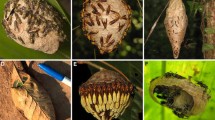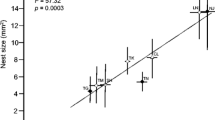Summary
Anelosimus eximius (Araneae, Theridiidae) is a social neotropical spider which occupies the rain-forests of South America. Each colony counts one to several nests connected by silk threads. Thousands of individuals of both sexes, as well as immatures, may inhabit, repair and clean a single web and cooperate in prey capture, while the females alone monitor egg-sacs and young individuals.
In French Guiana,Anelosimus eximius colonies were found along roads and rivers in primary and secondary forests. The colonies were mapped along two laterite roads, and their type of distribution was analyzed as well as the relation between the size of the colony and the distance to its nearest neighbour.
We found one hundred colonies along the two roads. Analysis of nearest neighbour distances (Goodness of fit test) shows an aggregative distribution of the colonies along these two roads. Furthermore, it was found that colonies form “colony complexes” — a large colony (five or more nests) surrounded by small colonies — althought isolated colonies were also found.
These results are discussed by referring to the different modes of colony foundation known in this spider species.
Resume
Anelosimus eximius (Araneae, Theridiidae) est une araignée sociale qui occupe les forêts tropicales humides d'Amérique du Sud. Elle vit en groupes pouvant compter plusieurs milliers d'individus des deux sexes et de toutes classes d'âge. Chaque colonie compte de un à plusieurs nids reliés par des structures soyeuses. Un nid se compose d'une nappe de soie en forme de hamac, surmontée d'un réseau de fils accrochés aux structures végétales.
En Guyane française, nous n'avons trouvé ces colonies que le long des fleuves et des pistes, mais pas à l'intérieur de la forêt. Certains mécanismes de la dispersion des colonies sont connus, mais il n'y a pas à l'heure actuelle, de données sur la distribution des colonies dans leur biotope. Dans cet article, à partir de la cartographie de populations de colonies de cette espèce, nous avons analysé leur type de distribution et essayé de voir dans quelle mesure les données sur la dispersion permettaient de comprendre ces distributions.
L'analyse des distances au plus proche voisin pour chaque colonie (Goodness of fit test) séparément pour chaque population, a montré que dans les deux cas, la distribution est de type agrégatif. En fait les colonies sont regroupées en complexes (comprenant jusqu'à 25 colonies) constitués d'une à 5 grandes colonies (ayant plus de 5 nids) entourées par un certain nombre de petites. Néanmoins, en dehors de ces complexes, nous avons trouvé des colonies isolées, séparées de plusieurs centaines de mètres, voire plusieurs km de toute autre colonie.
En conclusion, nous avons essayé d'expliquer comment à partir des modes de dispersion connus, nous pouvions avoir une telle distribution des colonies.
Similar content being viewed by others
References
Brach V., 1975. — The biology of the social spiderAnelosimus eximius (Araneae, Theridiidae).Bull. S. Col. Acad. Sci., 74, 37–41.
Burgess J.W., Uetz G.W., 1982. — Social spacing strategies in spiders. InSpider communication: mechanisms and ecological significance. (Eds P.N. Witt and J.S. Rovner) University Press, Princeton, pp. 317–351.
Buskirk R.E., 1981. — Sociality in Arachnida. InSocial Insects. (Ed. H.R. Hermann) Academic Press New York, pp. 281–387.
Campbell D., Clark D.J., 1971. — Nearest neighbour tests of significance for non randomness in the spatial distribution of singing crickets (Teleogryllus commodus, Walker).Anim. Behav., 32, 750–769.
Christenson T.E., 1984. — Behaviour of colonial and solitary spiders of the Theridiid speciesAnelosimus eximius.Anim. Behav., 32, 725–734.
Crips D.J., 1979. — Territorial behavior in barnacle settlment.J. Exp. Biol., 38, 429–448.
Darchen R., 1965. — Ethologie d'une araignée sociale,Agelena consociata. Biol. Gabonica, 117–146.
Elgar M.A., Godfray H.C.J., 1987. — Sociality and sex ratios in spiders.Trends in Ecology and Evolution, 2, 6–7.
Fowler H.G., Levi H.W., 1979. —A new quasisocial Anelosimus spider (Araneae, Theridiidae) from Paraguay.Psyche, 86, 11–18.
Jacson C.C., Joseph K.J. 1973. — Life history bionomics and behavior of the social spiderStegodyphus sarasinorum Karsch.Insectes Sociaux, 20, 189–204.
Krafft B., 1971. — Contribution à la biologie et à l'éthologie d'Agelena consociata Denis (Araignée sociale du Gabon) III.Biol. Gabonica, 1, 3–56.
Krafft B., 1985. — Les Araignées sociales.La Recherche, 16, 884–892.
Levi H.W., 1963. — The American spiders of the genusAnelosinus (Araneae, Theridiidae).Trans. Am. Micros. Soc., 82, 30–48.
Lubin Y., Robinson M., 1982. — Dispersal by swarming in a social spider.Sciences, N.Y., 216, 319–321.
Pain J., 1964. — Premieres observations sur une espèce nouvelle d'Araignées sociales.Biol. Gabonica, 47–58
Riechert S.E., 1978. — Games spider play: I behavioral variability in territorial disputes.Behav. Ecol. Sociobiol., 3, 135–162.
Riechert S.E., 1984. — Games spider play III: Cues underlying context associated changes in agonistic behaviour.Anim. Behav., 32, 1–15.
Riechert S.E., Roeloffs R., Echternarcht A.C., 1986. — The ecology of the cooperative spiderAgelena consociata in Equatorial Africa (Araneae, Agelenidae).J. Arachnol., 14, 175–191.
Roeloffs R., Riechert S.E., 1988. — Dispersal and population genetic structure of the cooperative spiderAgelena consociata, in west African rainforests.Evolution, 42, 173–183.
Siegel S., 1956. —Nonparametric statistics for the behavioural Sciences. Mac Graw-Hill Ed., New York.
Smith D.D.R. 1986. — Population genetics ofAnelosimus eximius (Araneae, Theridiidae).J. Arachnol., 14, 210–217.
Vollrath F., 1982. — Colony foundation in a social spider.Z. Tierspsychol., 60, 313–324.
Wickler W., 1973. — Colony formation and social bonding inStegodyphus mimosarum and other social spiders.Z. Tierpsychol., 32, 522–531.
Wilson E.O., 1975. —Sociobiology. Belknap Harvard University press, Cambridge, Massachusetts.
Author information
Authors and Affiliations
Rights and permissions
About this article
Cite this article
Pasquet, A., Krafft, B. Colony distribution of the social spiderAnelosimus eximius (Araneae, Theridiidae) in French Guiana. Ins. Soc 36, 173–182 (1989). https://doi.org/10.1007/BF02226302
Received:
Accepted:
Issue Date:
DOI: https://doi.org/10.1007/BF02226302




